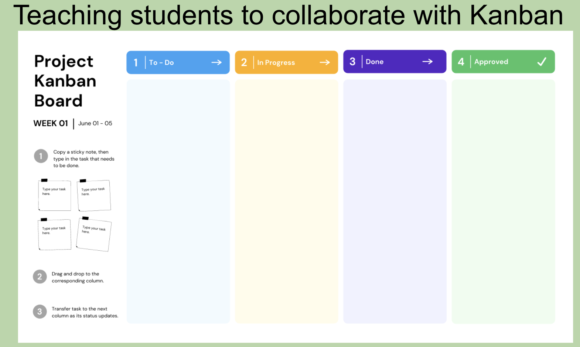
Making Collaboration Transparent with Kanban Boards
Today, I want to explore the power of making collaborative learning transparent.
What do I mean by that? Well for any of you who have ever been partnered with others on a project, think about that experience and reflect on the following questions:
- What structures or supports were in place for you to be able to seek out thought partners on your project team?
- What frameworks helped you calibrate your working pace?
- What prompted others to come and seek out your perspective?
When I talk about making collaborative learning transparent, that’s what I’m talking about: setting up scaffolding that helps all learners network and learn from one another.
The resource from the free guide that correlates with this theme is our KANBAN templates. If you’ve never used the Kanban method before, essentially it is a system that helps a team visualize where each other are at, on a given project. It often has the following columns: “to doâ€Â “in progressâ€Â “testing†“doneâ€
If students were co-authoring a podcast script they might divide and conquer a to do list: some students might be researching online, others might be interviewing other students, others might be writing to the local library as part of the ‘to do.’ When each member of the team has updated their progress, they update the Kanban board so they know where each other is at. What does this do for teams? Well, the first thing that might come to mind is accountability–and yes, this is great for each member to stay accountable to their team’s goals. But in my experience the truly big win by using this system is that it starts conversations during the collaborative process. One of the biggest pitfalls for students working on a team is that we don’t intentionally make time and space for regular check-ins. I’ve made this mistake as a teacher–and the stakes are high, when we don’t help teach the skills and structures of collaboration, students end up seeing collaboration as an obstacle for learning when we want them to see it as a catalyst.
I even have a few teacher parent friends who have adopted this method for their household set of chores. Why? They tell me it creates a better sense of how their kids can jump in and help out when they have extra time, and it also models to them how much is involved in keeping the house clean, the fridge stocked, and the family taken care of.Â
For me, when my team uses the Kanban method it also helps us make sure we really think through our priorities first. When you co-author a to-do list, you get the collective wisdom of others. For young learners this is huge. Even for an essay, asking students to all share their ‘to do’ starting place this will look different student to student, and when we invite them to learn from one another’s different starting places, they gain new entry points into that task. I think one of the most overlooked questions we need to remind students to ask each other more regularly is this one: “How do you get started?â€
When I was a young learner, whenever I had a research assignment, I didn’t always know how to get started. And you know what? When that first step is cloudy, motivation drops. I had no idea how much time my classmates spent on their research or how they went about doing it. That’s a barrier for learning. The more we can make the learning process transparent, the more welcoming the process becomes.
I use a lot of sports metaphors. Here’s why I think they work for our educational context: athletes are so used to the idea of slowing down their technique. As a baseball player, my hitting coach would have me take hundreds of practice swings–and these were without a pitcher, sometimes with a bat, sometimes without it. My hitting coach wanted me to be able to memorize the motion, and really understand the exact position my elbow needed to be in, to feel the proper pivot on your back foot. We need to give students learning to collaborate more opportunities to slow down and isolate the moves needed inside of collaborative teams. When we do this right, we help lessen the anxiety about working together, we help students build their confidence, and we help build a sense of belonging.






